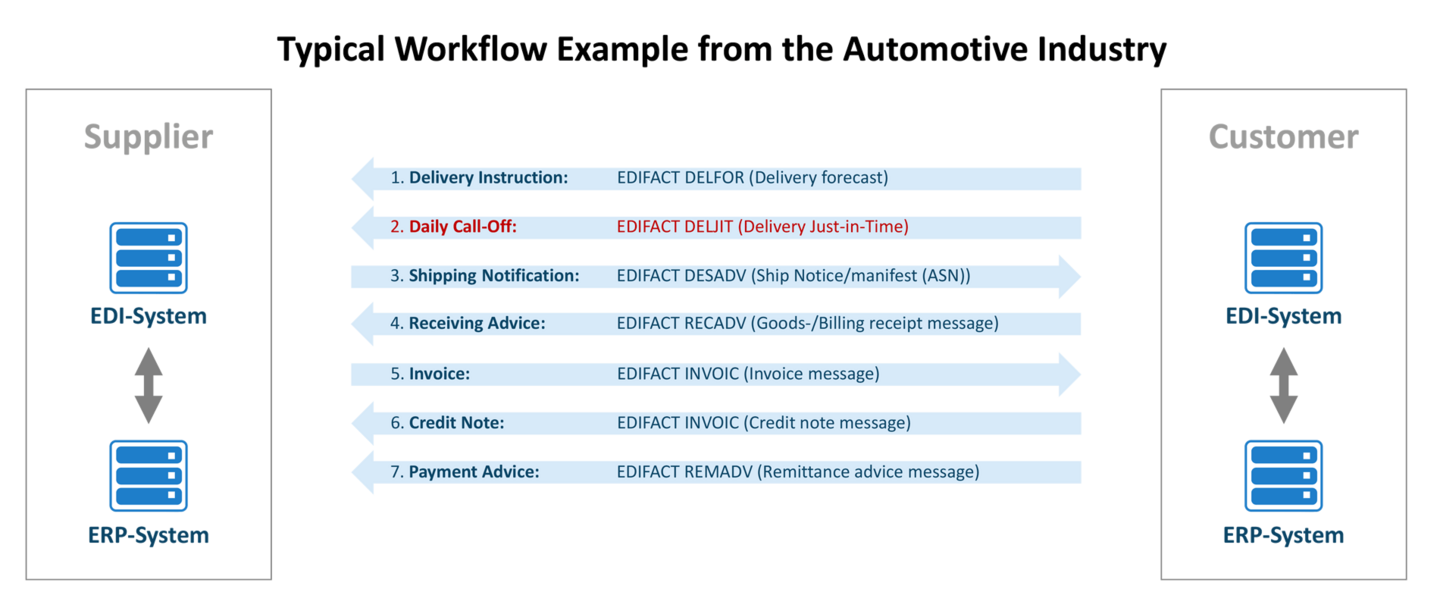
What is an EDIFACT DELJIT Message?
The EDIFACT DELJIT (DELivery Just-In-Time) message is used to describe short term delivery information and Just-In-Time scheduling requirements. A DELJIT message is an electronic planning schedule sent from the customer to the supplier. It follows the EDI message standard UN/EDIFACT and is a key message type for the electronic purchasing process in manufacturing industries.
The use of the EDIFACT DELJIT Message
A DELJIT message is sent by a customer to notify a supplier of the immediate delivery demands and can be received daily. Whereas the EDIFACT DELFOR (DELivery FORecast) is a Forecast of the future, the DELJIT is a very precise schedule of expected dates and times, describing the delivery expectations over the forthcoming days and weeks. The DELJIT is intended to supplement the information given via the DELFOR message, therefore the DELFOR and DELJIT are designed to be used in conjunction with one another.
These messages are normally generated via an ERP system and exported into an ERP specific data format, such as a SAP IDoc. The data is then converted from this in-house format into the customer’s specific EDI DELJIT structure via their EDI Solution. Once received by the supplier, this will then update their planning schedule.
How does a typical EDIFACT DELJIT Structure look like?

The DELJIT EDIFACT message contains many specific segments and elements. As well as the many mandatory segments required for every DELJIT message, there are also a large number of optional fields that different suppliers may require for their specific ERP systems. An EDI planning schedule message is sent, received, and processed by an EDI solution. The solution can be an EDI Cloud Service or EDI software for in-house usage.
A typical EDIFACT DELJIT Message includes:
- Product/service information, such as product identification, description and identification numbers
- The precise date, time and quantity to be delivered
- Contract/purchase order/reference numbers
- Ship to address (plant and dock/gate addresses)
- Packaging details, such as identification and number of physical packages
Processing of the EDIFACT DELJIT Message
Once the supplier receives the DELJIT EDI message, their EDI system will check the contents of the file against their EDIFACT DELJIT specification and send back a functional acknowledgment, confirming the receipt of the planning schedule.
DELFOR vs DELJIT Messages
A customer would first send an EDIFACT DELFOR message to their supplier, describing their long term delivery requirements. Once this has been received and processed, a DELJIT message can be sent to supplement this information, requesting the more immediate requirements that they have. DELFOR messages state a longer (sometimes several months) planning forecast, whereas the DELJIT message highlights a much shorter timescale, normally between 24 hours and 10 days, and can be sent on a daily basis.
EDIFACT DELJIT Example in the EDI Workflow
Within EDI, documents are exchanged between the business partners in a typical sequence of steps, dependent on the specific industry they are working within. The example below shows a standard manufacturing workflow, highlighting when a DELJIT would be used along with other standard messages.

What are the equivalents of EDIFACT DELJIT in other EDI Standard Formats?
Two direct comparisons with EDIFACT DELJIT message would be the VDA 4985 JIT Delivery Instructions message, or an ANSI X12 862 Shipping Schedule message. VDA (‘Verband der Automobilindustrie’) is a very common EDI standard within the Automotive industry, and ANSI X12 (The Accredited Standards Committee X12) is a very common set of standards within the NAFTA region.
Typical Errors when using the EDIFACT DELJIT Message
Similarly, with the DELFOR messages, problems can occur when planning schedules are generated with incorrect or unknown master data from the ERP system, such as incorrect order references, part numbers, or differences between Delivery Location codes. DELJIT messages are considerably more time-sensitive than the DELFOR, due to the shorter time scale reported on.
Benefits using EDI and the EDIFACT DELJIT Message
Planning schedules are generated and delivered faster, so any out-of-stock or over delivery scenarios can be avoided
Less incorrect deliveries due to human errors
Can reduce costs throughout the entire delivery lifecycle
Better supplier ratings
Ensure stable use of EDIFACT Delivery Just-in-Time
Integrated manufacturing lines are typical for the automotive industry and small mistakes can take entire assembly lines down. Thus EDIFACT DELJIT and DELFOR are mission critical processes for very sophisticated Just-in-Time supply chain management which is the base for such integrated manufacturing lines. SEEBURGER provides you all options for mission-critical operation of B2B/EDI integration.









